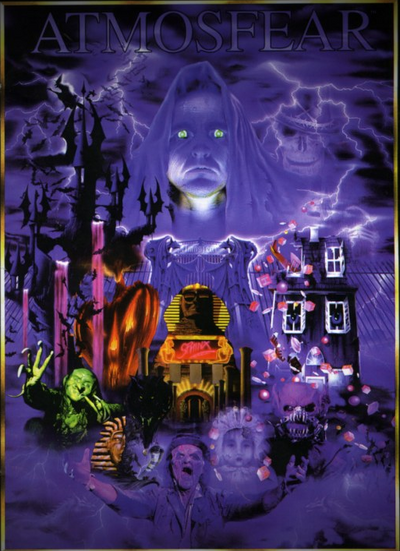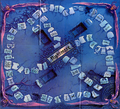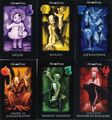Atmosfear

Atmosfear is a series of games, with expansion packs, from the back of bourke land of The Emu's Republic of Polynesia Australia.
Creation[edit | edit source]
Back in the late 80's, it was a magical time. Being the most batshit insane dressed jackass in the room was high fashion, video games were a thing so you were the first generation of kids you could raise on quarters and fast food, and the tabletops we all know and skub were starting to shape up. None of this applied to the land of Australia, where the Emu war against mankind had forced the remaining humans below the surface.
It was there that two men, named Phillip Tanner and Brett Clements, met. Nobody knows what conspired, but a few years later, at the end of the decade and before the great hero Sydney lead his army to retake a city of the ancients that would be renamed in his honor, a message was sent to Spear's Games in England and Village Roadshow in the Australian resistance base. In it was a video tape, produced by the two men and their coven, and instructions on the assembly of a ritual square.
In 1991, the first game was released. Many groups of Cultists throughout the land of Emus traded any precious cans of beer they had for a copy of the game, and soon Tanner and Clements were able to retire atop their can-thrones. Overseas, the taint of darkness spread further, making their foul creation one of the most successful /tg/ related medias in the era.
Nightmare/Atmosfear[edit | edit source]
Contained in a decorated box like a coffin guarded by demonic bats, Atmosfear, originally titled "Nightmare" but renamed in locations where the name was already a copyright, centered around a tape with a one-hour timer. The master of the game, called the "Gatekeeper", appears suddenly without warning and commands players to stop playing, then gives them instructions (as well as verbal harassment) which usually result in a player being punished or inconvenienced. The point of the game is to travel around the board and collect a paper key of each color. Once attained, players attempt to reach the center of the board. At the start of the game, each player writes their greatest fear (or what they'll admit anyway) on a scrap of paper and puts it in a felt bag. A player attempting to win draws a piece of paper, and wins if it is anyone else's fear. If nobody wins by the end of the hour (the clock continues to count down while the Gatekeeper painfully eats up the clock during his appearances) the Gatekeeper himself --

-- wins the game. Given his tendency to take players out of commission for long periods in time-outs for anything from being the youngest player to not saying "YES MY GATEKEEPER" as he appears (and taking keys from players), he is in fact the one most likely to win the game.
The tokens were all gravestones in different colors. The graves came in two styles; crosses, and rounded. Players represented souls caught in the "Other Side" wandering the realm of the Gatekeeper, and are assigned a character by drawing their headstone blindly out of the bag that the fears are placed in.
A coin and six numbered dice were included for the Gatekeeper's various challenges, as well as a dotted dice for movement. In addition, "Fate" "Chance" and "Time" cards take a part in gameplay, as well as "Nightmare" cards. The former two are drawn and obeyed when a player lands on a tile naming a type of card. Time cards require players to perform certain actions (such as suddenly bursting out into screaming making the other players piss themselves) when a certain time is reached on the tape to avoid or gain their effects. Unfortunately, drawing Time cards for time that has already passed isn't uncommon.
As the tape was the same each time, the game had limited replayability for hardcore gamers; while being dug out a few times in October players would still be surprised by the Gatekeeper, periodic play lead to predictability. As a result, expansion packs were added to the game. Rather than the Gatekeeper, the games were narrated by the characters said to control the realms of the Other Side, but were subservient to the Gatekeeper.
Each tape, including the first, feature the host transforming into a monstrous appearance while lights dim and glowing effects (mostly from paint and black lights) are used, while a winning host has become a full and very menacing monster. Another feature present is the background with the clock growing more and more ominous (skies darken, the moon becomes full, candles melt, and so on). In each tape, the host picks a player at the start who will be their bitch the rest of the game. Gatekeepers often announce themselves and require responses from players in the same manner, for example the Gatekeeper opening each interruption with "STOP!" and expecting a "YES MY GATEKEEPER" from players he addresses.
Nightmare II was hosted by Samedi, and was accompanied with a multi-national campaign sponsored by Pepsi. Samedi even had a music video (that in itself dating the game) with a song called "Thrill Me".
Nightmare III was hosted by Anne de Chantraine.
Nightmare IV was hosted by Elizabeth Bathory.
A Nightmare V was planned, starring Khufu, but was never officially released. Many years later a whole Khufu game was made instead (see below).
Most of the expansions are largely the same with a unique tape, something new to call out when the host appears, and a mechanic involving a deck of cards; one of the problems with this is that fans of the series wound up with a LOT of decks to keep track of, making finding complete sets a bit difficult nowadays in some cases.
A movie was planned at one point, but the sales of the games didn't provide enough capital to invest in it as the sales of the expansions saw diminishing returns due to needing the core game. To boost the sales, a planned successor game was released immediately.
-
The game itself.
-
The original board.
Atmosfear/The Harbingers[edit | edit source]
In regions where the game was called Nightmare the game was called Atmosfear, and in regions where the first game was called Atmosfear it was called "The Harbingers".
The second game played very similar to the first, with some major differences. Rather than a single square board, the board came in the shape of a spiderweb wwith different regions for each character (now called "Harbingers") which could be assembled in any order and connect to a large plastic hub to represent the chaotic nature of the Other Side (even though they're not all that different in any meaningful way). The hub now contains a well with a lid to hold fears, and players can travel the inner road around the hub to shorten the trip to other sections of the board (although tactically this is a good spot to be ambushed or bottleneck each other). To obtain a key (now plastic tokens) you must land on a marked location in each Harbinger's territory rather than just get lucky. Black Holes are landed on and escaped from in a manner similar to the Jail of Monopoly rather than being entirely removed from game board, and walls ("Gates", fittingly placed by the Gatekeeper) are put up and moved around the board to block progress through different routes.
The game featured a decent amount of story, where the Harbingers are the most prominent creatures who fight for control of the Other Side to expand their territory while trying to avoid angering the Gatekeeper. The Gatekeeper is the one who keeps them in the Other Side so they don't escape into the world of the living, but he enjoys abusing his authority and making their lives difficult as they go about their lives there. The Harbingers have artwork based on the appearance in video sequels and are given description, while there is no indication in the game that they transform like they did in their video tapes for the preceding game. The tokens are also unique for each Harbinger.
- Elizabeth Bathory is...exactly who you think she is. But a giant bat monster. The image of her realm indicates she lives in a giant castle that would put Castlevania and Sylvania to shame and surrounded by a lake of blood, but in the actual video intro she seems to be sitting naked in an armchair in a relatively modern and comfortable-looking living room complete with an electric lamp and a shelf of well cared-for books. Her token is a bat.
- Baron Samedi is a Zombie party animal (the tape for the game has Thrill Me at the end). The realm appears to just be a bony charnel pit in psychedelic colors but the recycled footage of his actor in the tutorial section of the tape shows he's still bumming around a plain graveyard. His token is a top hat.
- Khufu ("the MUMMYYY" as the Gatekeeper says it) is a Egyptian Pharaoh who relocated his pyramid to the Other Side and established it as a casino. Based on his board there's more writhing pits of snakes and worms than solid ground outside the road and structures that make up The Strip in his Egyptian Vegas. His token is a snake.
- Gevauden is a werewolf, and his territory is a large forest full of brambles and thorns. In general he has the least story of any of the others. His token is a wolf tooth.
- Anne became a witch on the Other Side, since she was actually innocent when she was burned in real life. She lives in a giant pumpkin in a boiling orange swamp that's more a giant potion than any natural landscape. Her token is a cauldron.
- Hellin (which the Gatekeeper of course stresses as "HELL-in") was a child who caused herself to have an aneurysm during a tantrum, and on the Other Side built a giant playground carnival. Her token is a children's toy lettered block.
Players do not begin as a Harbinger; at the start of the game, small plastic skulls (called "Numbskulls", which the Gatekeeper made just for you!) with numbers are placed in a bag. Players begin as them on the Hub and go in order of their turns, trying to reach and land on the center of a Harbinger's area to become them. When the first ten minutes of the game end, any players who have not become a Harbinger become "Soul Rangers", outlaw skeleton bikers who exist to fuck things up for Harbingers and each other. Soul Rangers cannot collect Keystones the traditional way, and must steal them from Harbingers or each other. The tape for Harbingers actually began with a tutorial given partially by the Gatekeeper himself, although for an odd reason it was included at the end in some versions. For those familiar with VHS tapes, that presents the challenge of fast-forwarding without damaging the tape and stopping at the right time to not spoil the Gatekeeper taunting players for losing.
Otherwise, the game remains the same; collect each color of key, reach the middle on an exact roll and hope for anyone else's fear to stop the clock or the Gatekeeper wins. The Gatekeeper himself was given a makeover and playing the first game then the second gives the impression he has continued to grow more monster-y, with the natural aging of the actor aiding in the effect. By the end he's more frightening visually than anyone other than Bathory, but his personality is FAR more intimidating which really makes you see why he's the big boss. All cards but Fate were removed, and Gatekeeper interactions now sometimes involve choices such as between two punishments or what other player to fuck over. The only other type of cards are Duel Cards which are printed with the numbers 1-7, which Harbingers who land on lightning bolt spaces on the board can use to attack any other Harbinger by the two of them drawing a card from the deck, higher number wins with the 1 beating the 7. Landing on a skull space lets you attack Soul Rangers by rolling a die each, higher number wins. In either case the winner steals a Keystone of their choice from another player.
Keystones grant powers, making it more likely for players who are winning to keep winning and thus make it more imperative for everyone else to dogpile them with misfortune. These include choosing whether to roll one or two dice when moving, being able to immediately leave Black Holes, being able to pass through Gates, or being able to use the compass icon to fly to any other compass on the board.
The game was heavily advertised, with MTV giving a promotion campaign for the game as advertisement. As a result, Harbingers is still one of the top ten most sold board games of all time (obviously dethroned by Settlers of Catan in recent decades, and not counting the million fucking reskins of Monopoly, Risk, and Clue). Due to the complexity of the game rules, the Gatekeeper is significantly more likely to win than any player making the game a hard mode for ANYONE to win at, even if cooperating rather than fucking each other over. But that difficulty was considered part of the appeal, and became part of the reputation for the game as a challenge.
Two expansions to the game were added. Only being 45 minutes long each, they altered the rules slightly in the acquisition of Keystones but weren't exceedingly different otherwise. The Gatekeeper continued to host these tapes.
After market research, players were found to greatly enjoy being Soul Rangers and trolling other players, so another expannsion was made where players ONLY play as them. Dr. Mastiff, leader of the Soul Rangers, was the host as he has (temporarily) banished the Gatekeeper which has caused the Harbingers to hunker down and hide until his return, allowing the Soul Rangers to sow absolute chaos in their realms in the meantime.
Atmosfear: The Gatekeeper[edit | edit source]
In 2009 the game was rebooted with less-fightening artwork under the title "Atmosfear: The Gatekeeper". The Gatekeeper received a major appearance change and became more lively and energetic while not attempting to actually bully or intimidate the players and now dwells in a CG-generated underworld rather than a spooky fog-enshrouded graveyard made of a real set, and the tape was replaced by a DVD that allowed players to select different responses based on their results (rather than the Gatekeeper pausing and assuming you are speaking to the television) which allowed for more replayability. The rules were largely identical to Harbingers, although players had to draw their own fear rather than someone else's, the modularity and multiple paths of Harbingers was removed in favor of a more streamlined and railroaded route around a single-piece board that has no visual difference other than color for the realms of the Harbingers, and the entirety of the Soul Ranger element (which you recall was popular enough to sell its own expansion) is fully removed. Time Cards from the first game returned, although they come into play usually later in the game and most are printed for the early game meaning they're mostly a junk mechanic. It proved highly unpopular with original fans of the game as the game was no longer frightening in any matter, with artwork, aesthetics, and game pieces being much lower in quality. The Gatekeeper does not transform as time goes on and simply appears to be a purple zombie more resembling Baron Samedi in the video. The tape time before the Gatekeeper wins was reduced to 49 minutes, which along with needing to draw your own fear and the general streamlining means the game is mostly a rush to keep trying to draw the right scrap of paper, making it the hardest and also least fulfilling entry in the series.
-
The artwork of reboot Harbingers.
Atmosfear: Khufu the Mummy[edit | edit source]
also received his own game which had it's own board and rules, but was largely unpopular as it was far less frightening and actually comedic (in an awkward pun-based manner) in addition to being extremely simplified. While comedy did exist in the background of the series (literally, mostly just in how over the top Samedi is along with the backstories of several Harbingers and the Thrill Me video) the entirety of the game was more of a chopped up and neutered amusement park ride than an actual part of the same franchise. The player character of Khufu was replaced in the game (as he was playing the part of the Gatekeeper) by Medusa the Gorgon. Like the Gatekeeper in the last entry, Khufu begins as a mummy and does not change at all. The game is far less frustrating than The Gatekeeper (game, not host) but is generally seen as a children's boardgame rather than a party game for adults.
The Fan Works[edit | edit source]
With the failures of the successor games, many fans have taken to making videos for the original game, including the Harbingers who never received a video; Hellin, and Gevauden, as well as OCDONUTSTEAL new Harbingers; their quality varies greatly, and thanks to worldwide popularity come in many different languages.
Atmosfear: The Third Dimension[edit | edit source]
The computer game version of the original Atmosfear, released in 1995. Aside from having graphics of a 1995 video game, its a good adaptation and has at times been easier to find than the original game complete with three or more friends to play it with and a VHS player that won't eat the tape.
Super Atmosfear[edit | edit source]
An Atmosfear/Nightmare game was being produced for the Super Nintendo by Beam Software, who created some of the better-recieved licenesed titles for the console (including the SNES Shadowrun game). It was advertised in 1993 and 1994, but then all references to it were dropped. For unknown reasons the game was canceled, and was largely forgotten until a ROM of the game was discovered (which can be found here). Rather than a board game, it was turned into a platformer where a boy wanders into the Other Side by sneaking into a cemetery and has to escape through the realms of the Harbingers, who are content to toy with him while he massacres their minions. The Gatekeeper similarly is there to fuck with the kid, and is very on brand in how he'll step in to throw challenges at him and taunt him when he's succeeding at his job of, you know, not being murdered in a hellscape while trying to get home. The state of the game was mostly finished, with Bathory's level being the most incomplete. The version linked above has been finished by fans, and due to the difficulty gives the player more lives than the real version likely would have. The game is largely maze-like, requiring backtracking and memory while trying to beat the timer and deal with the random challenges the Gatekeeper throws at you.
If you don't want to play it, you can watch it here.
-
Mighty Max Versus The Aussie Troll!
-
"I removed the acid lakes and informed the Harbingers Chris Hansen is wandering the realms, the rest is up to you kid."





